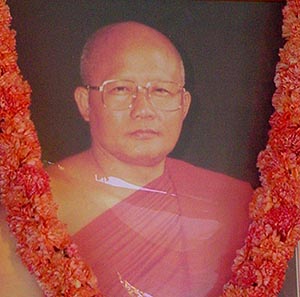


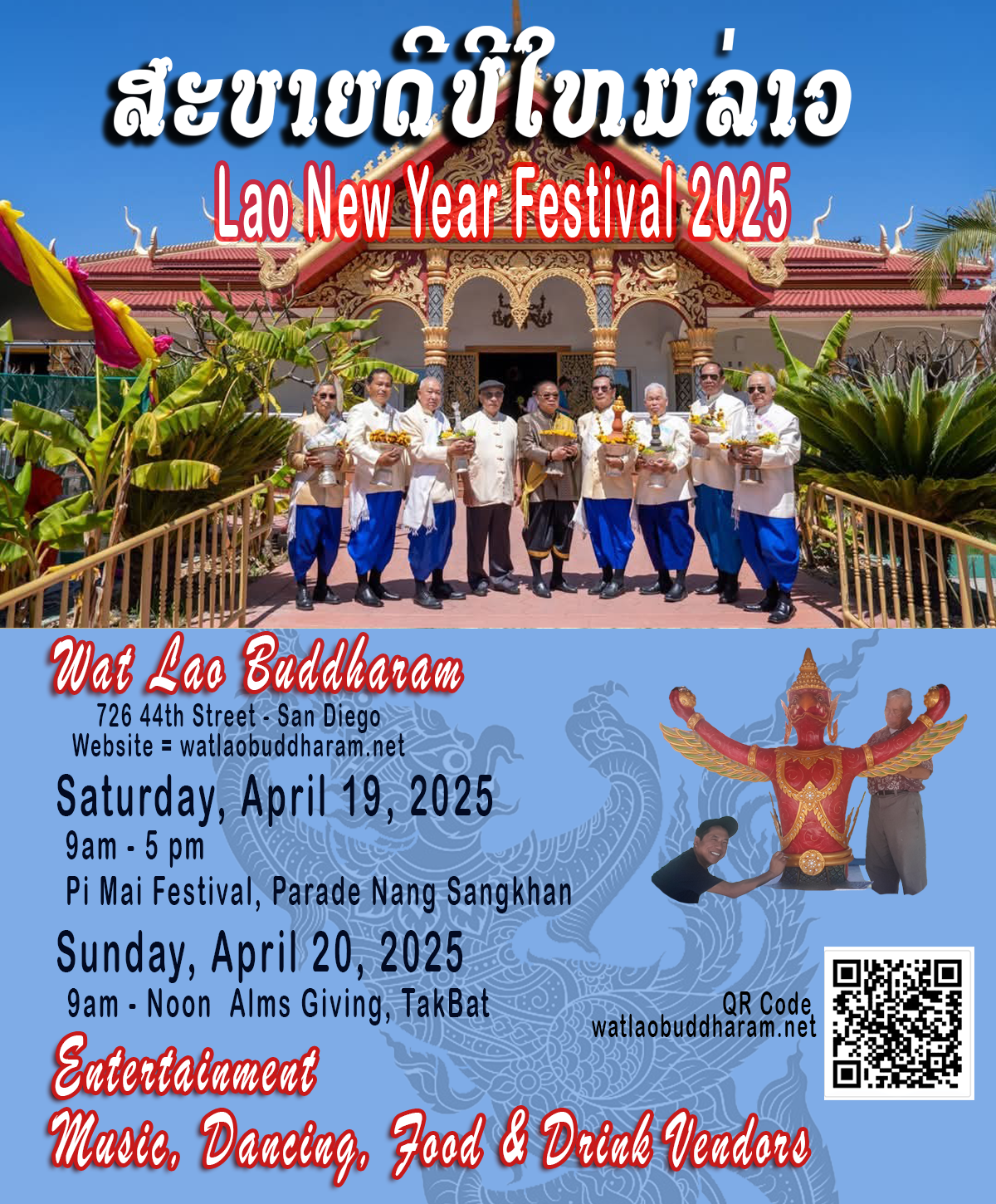
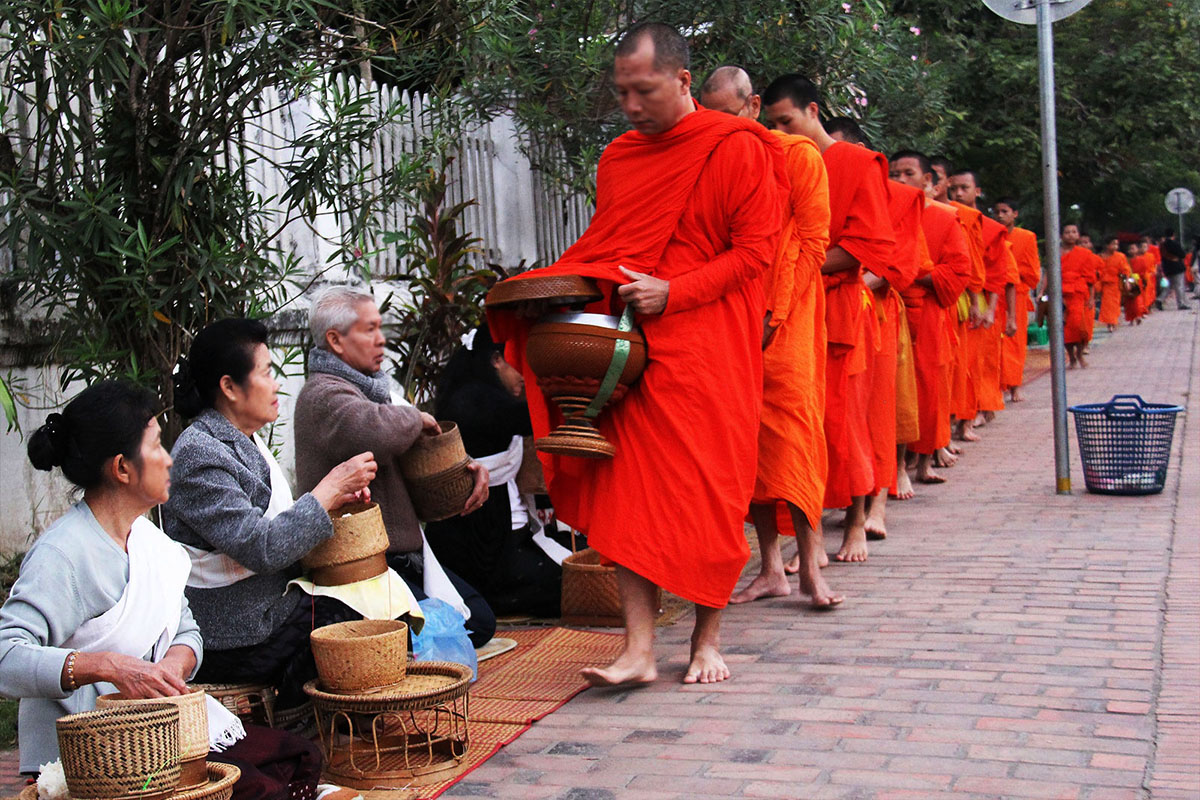
Centuries old tradition "Alms Giving or Tak Bat" is a sacred and silent ceremony that takes place each day allowing the community to give back to the temple monks who sacrifice on their behalf.
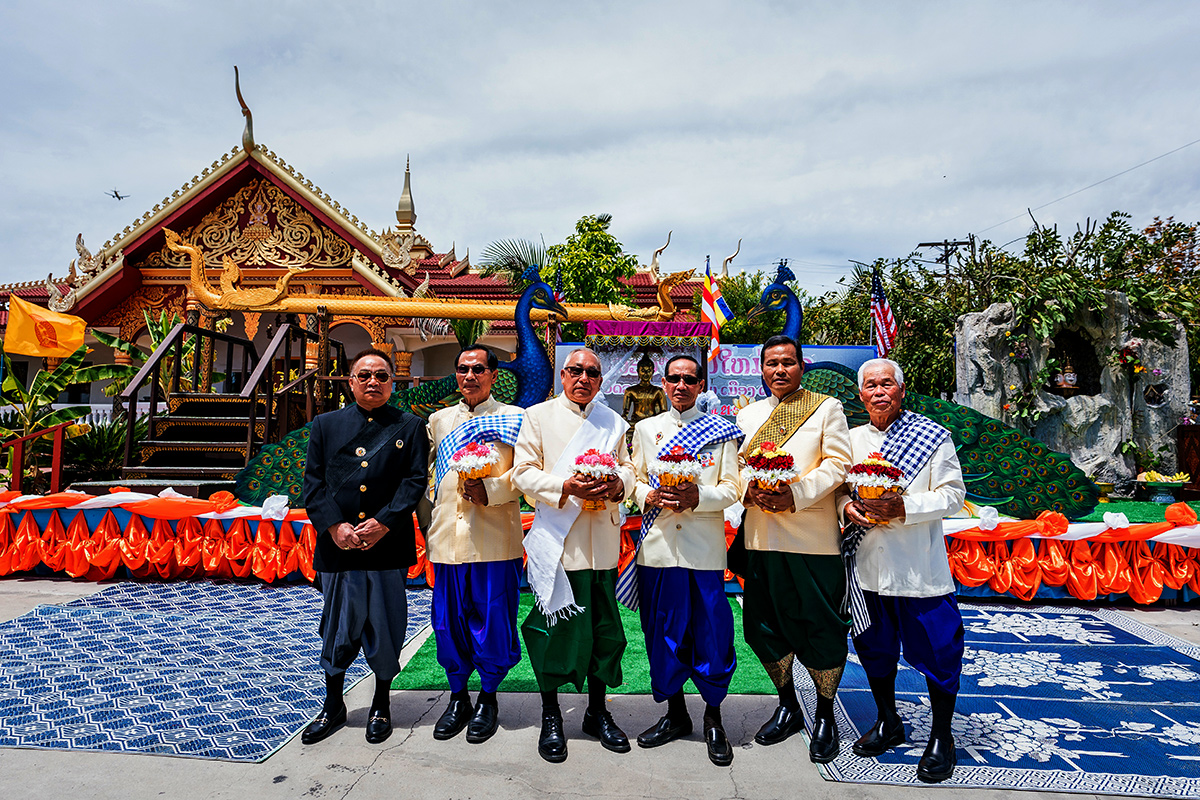
Wat Lao Buddharam Community Leaders
Please contact your temple representative to find out about volunteer opportunities for all temple events. Community involvement is always welcome.

January 2025
Over the last year or so there have been a growing number of unprovoked attacks on American minority groups including Jews, Muslins and Asians of all faiths. Crimes of hate seem to be being stimulated by warring factions in the Middle-east and around the world. Please be mindful of this when you are away from home and especially if you are traveling alone. The best defense may be to stay vigilant and protect ourselves and those we love.
_____________________________________________________________________________________
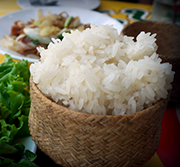
We Give Thanks for the Harvest.
This holiday is celebrated after the rice harvest. A baci ceremony takes place to give thanks to the spirits of the land and encourage good luck for the next harvest.
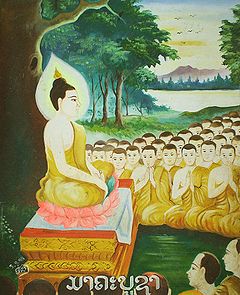
Boun Makha Busa (also Bousa) is a Buddhist festival in Laos that falls on the night of the February full moon day. This annual festival commemorates the speech given by the Buddha to 1250 monks, and to the people who took care of him. The speech given is known as "Ovadha Patimokha" which mentioned that people must not fish, must do good deeds and must purify their minds. It is an occasion when Buddhists go to the temple to perform merit-making activities, such as alms giving, meditation and listening to teachings.
Boun Khao Chi is an annual festival where the laypeople would make a special bread of sticky rice dipped in egg batter and grilled . This bread is specially made so that it could be given as an offering to the Buddhist Monks in the morning.
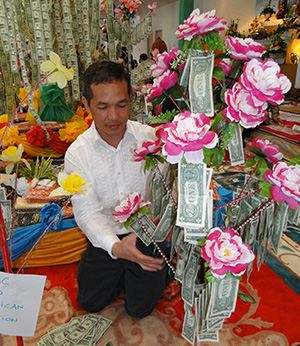
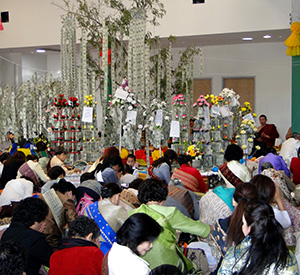
The "PHA PA" ceremony can happen at any time in the year. The name "PHA PA" can be translated to "clothes forest". A long time ago, monks only wore clothes made from old rags of dead people. So faithful people sometimes placed fresh clothes on the tree branches in the forest. That is the origin of the "PHA PA" ceremony. It celebrates the merit of giving by providing monks clothes and temple building materials. The 'money tree' represents the clothes forest tradition of giving to the temple via the monks.
Wat Lao Buddharam San Diego will celebrate Lao New Year (Pi Mai) on Sunday, April 21, 2024 with a community festival, pageant and parade. The 7 daughters of Thao Kablinaphrom will ride on the ceremonial float while they reenact the mythology. Water is a big part of the New Year celebration symbolizing life and renewal. It is for washing homes, Buddha images, monks, and soaking friends and passers-by. Children first respectfully pour water on their elders, then monks for blessings of long life and peace, and last of all they throw water on each other.
Happy Birthday Bea Manisouk
Boun Visakha Bousa, also Boucha, Buddha Day, is a very special anniversary simultaneously venerates the three most important anniversaries in the life of the Lord Buddha: his birth, his enlightenment, and his death. Rejoicing Buddha similarly means taking exceptional efforts to bring happiness and luck to those less fortunate like the elderly, the hospitalized and the sick. On this day, Buddhists will offer gifts and cash and other kinds of charitable gifts to those with circumstances more arduous than their own. Vesakha is also a time for great joy and happiness, as well as making use of ones skills unselfishly. Buddhists are encouraged to help decorate their local Buddhist temple with ornate and colourful decorations and painting and generating beautiful scenes from the life of the Buddha for the public to see.
Boun Pavet or Boun Phravet or Boun Phra Vetsandon, is the Lao religious holiday that celebrates the parable of Prince Vessantara, the last pre-incarnation of the Buddha. The parable speaks of absolute charity. At the Wat Lao Buddharam in San Diego, Boun Phravet includes a temple parade with monks chanting, floats depicting Peccaya the white rain-giving elephant and participants singing and dancing. The baci (blessing) ceremony is stardard fare for most Lao religious events where blessings for prosperity are shared. All around the temple small beds are set up by individual families and upon the beds are placed all manner of things they wish to symbolically give to their ancestors to ensure their comfort like food, clothing, bedding etc. Money trees are common at each bedside and festival participants donate money to the temple through the family trees.
Buddhist Lent is a period of three lunar months during the rainy season when monks are required to remain in one particular place or wat (temple). Monks and novices have to swear themselves to live in the same place. They can’t stay in the other places over night. During this period, monks are practicing meditation more than usual. Every full moon day, monks have to gather in one temple to recite “Phadhimoka” or 227 rules of monk. Khao Phansa Day is on the first day after the full moon of the eighth lunar month and marks the beginning of the three-month rainy season.
Ho Khao Padapdine means’’ to packets of rice and place them on the floor’’.
According to the precepts of Buddha, the Buddhist Lent is the good time to refrain from bad deeds. Buddhist should apply the Dharma: the respect of the five commandments of the Buddha, meditation and alms. It is also time to complete the agricultural work, as transplanting of paddy.
To celebrate the Boun Khao Padabdine Ho, the Buddhist are preparing offerings composed of Tomh Khao, Khao Nom Neb (cakes made with rice), fruits and other kind of foods that will be offered to monks . These religious activities are intended to honor the dead and the spirits.
Boun Khao Salak, 15 days after Boun Khao Padap Din, ritual ceremonies happens in the same way except for one thing. This time people number the offerings, and the monks will draw them. Each monk receive also in this manner a list of people to pray for (listing the names of the dead persons the family wishes to honor).
Basic necessities such as soap, toothpaste and, toothbrushes compose the offering this time. Boun Khao Salak helps people to go throught this time of penance. It also marks the entrance in the second half of the Buddhist Lent. This simplicity in life will end with the festival of Boun Ok Phansa.
Read More About Boun Khao Salak
Boun Ok Phansa - also Ork Phansa, marks Buddha's return to earth and signifies the end of Buddhist Lent when after three months of retreat, the monks return to their daily social activities. At dawn of Boun Ok Phansa, followers gather at temples across Lao to give donations and offerings. In the evening, beautiful candlelit processions are held at the temples and hundreds of colourful floats of flowers, incense and candles float down the Mekong River. To prepare for the celebration, families make a small round container to put candles, flowers, incense or food and money.
At the bank of the Mekong, they then light the candles, say prayers and send the boat of light floating away down the river. This tradition is observed to pay respect to the river spirits, especially the Mekong River which means Mother of All Things. People also believe that this is a way to send away all negativity such as sickness, bad luck, shortcoming, and failure.
The end of Buddhist Lent is also celebrated with fabulous boat races along the Mekong River in Vientiane.
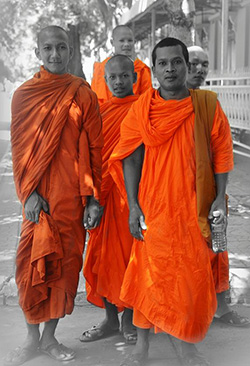
Maha Katin, also Thot Kathin celebrates the end of the Buddhist Lent and a replenishment of the temple monks. Buddhist monks throughout the country are free to move from place to place and are eligible to receive new robes in an annual presentation ceremony called ”Thot Kathin“. Beside new robes, Buddhist literature, kitchen equipment, financial contributions and building materials e.g. nails, hand-saws and hammers etc. are also presented to monks on this occasion.
The word ” Thot” means “making an offering to the monk” and the word “Kathin” literary means the “embroider frame” used in sewing the yellow robes. Buddhists regard the “Thot Kathin” ceremony as a most significant form of merit-making.
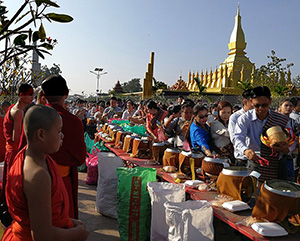
Pha That Luang – which literally means ‘great golden stupa’ – is said to have undergone many transformations over the years. Known as a Buddhist stupa nowadays – a hemispherical structure used as a place of meditation – Pha That Luang actually started life in the 1st century as a Hindu temple. In later years Buddhist missionaries and monks from India visited the stupa – the monks were said to have brought a breastbone of Lord Buddha as a relic. Pha That Luang festival The Pha That Luang is the scene of the country’s most important Buddhist festival, the Boun That Luang, held during the full moon of the 12th lunar month. Thousands of people flock to the grounds for three days of Buddhist ceremonies and celebrations to pay respect to the golden stupa and to give alms to hundreds of monks. Buddhist devotees walk around the That Luang three times holding incense sticks to pay their respect.
